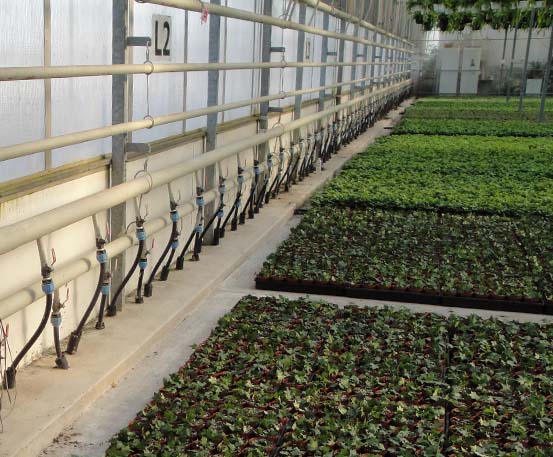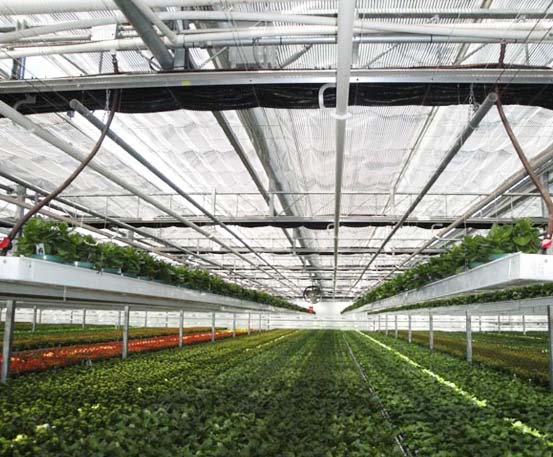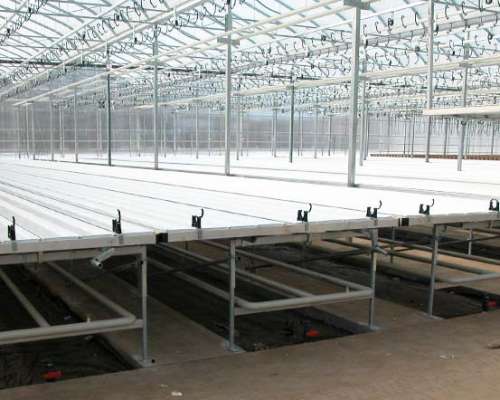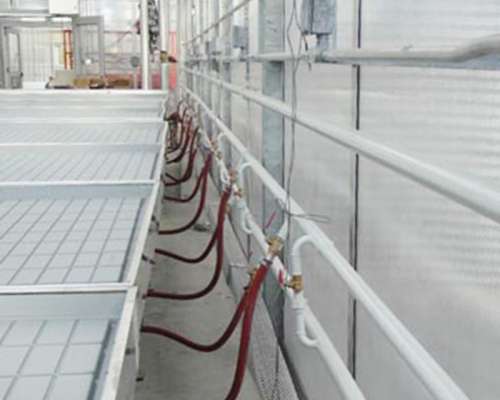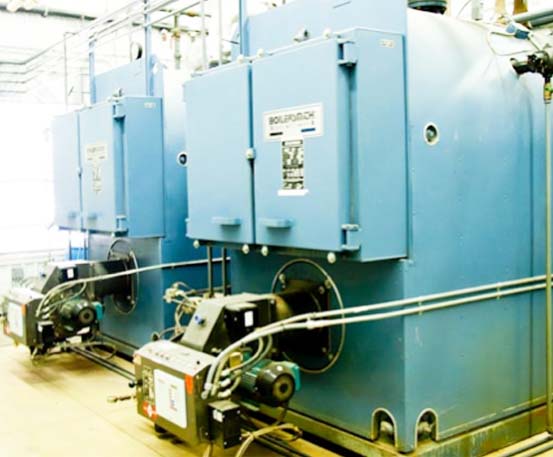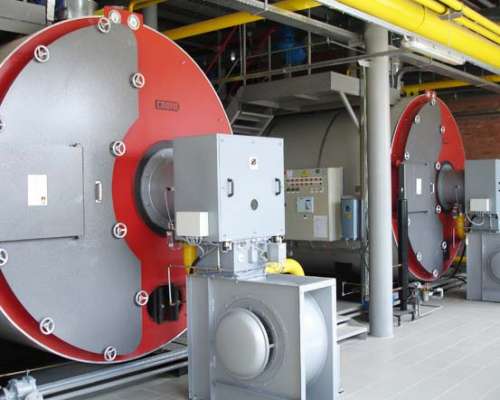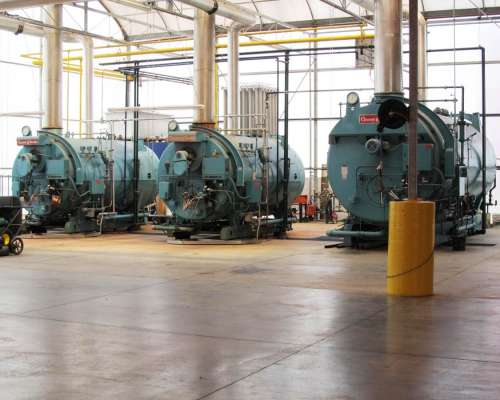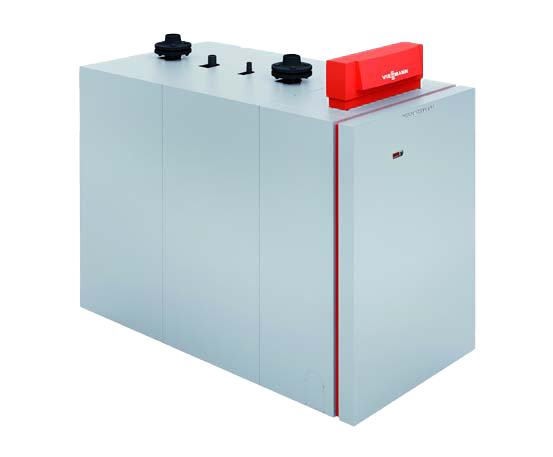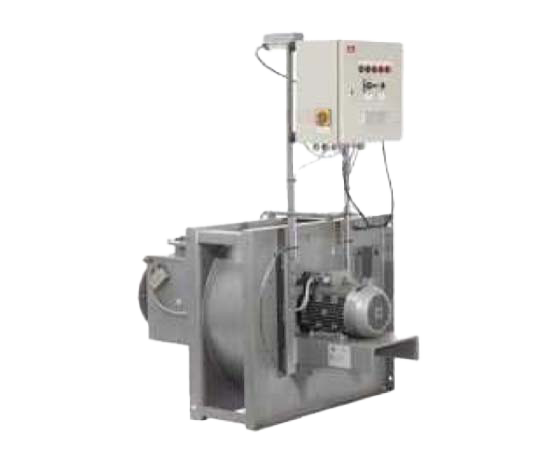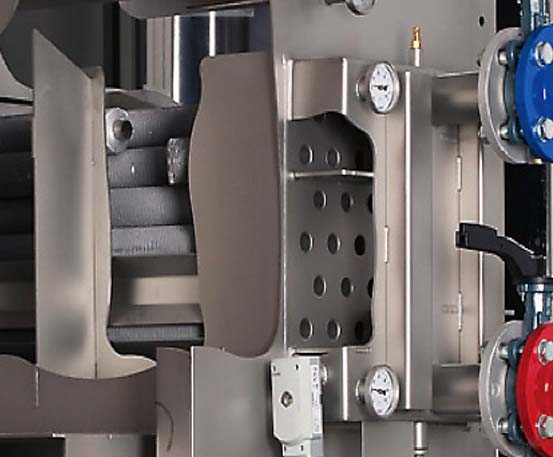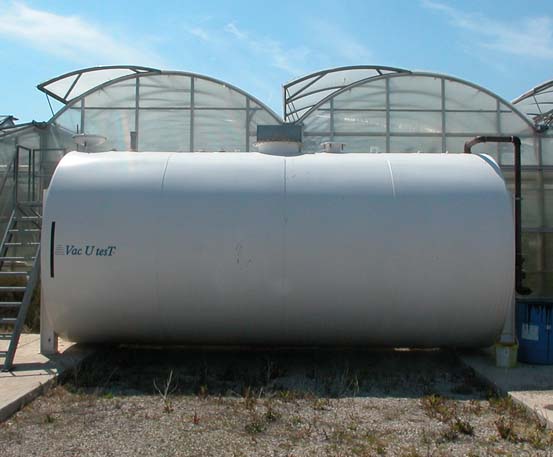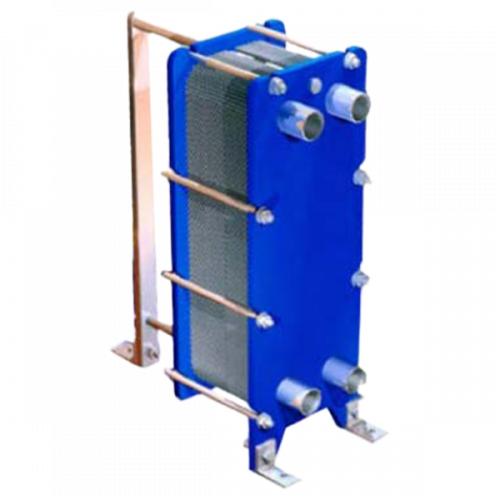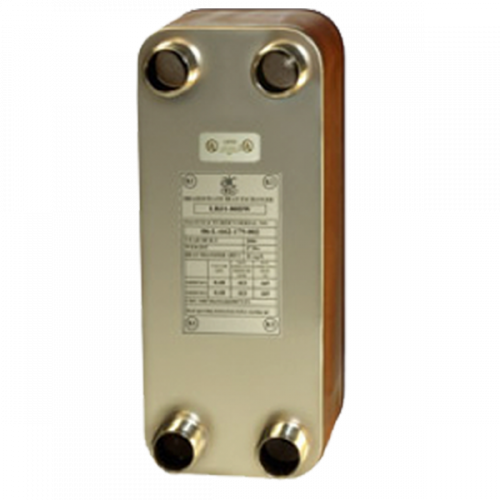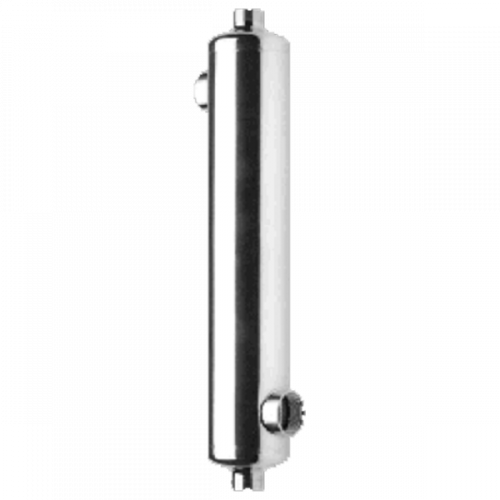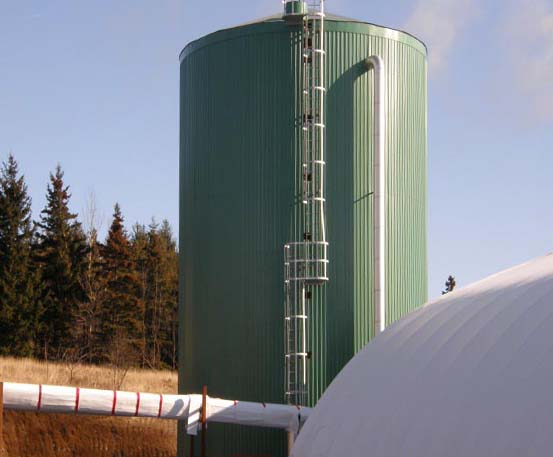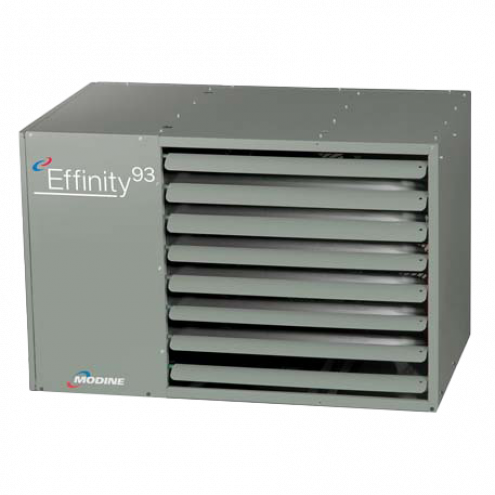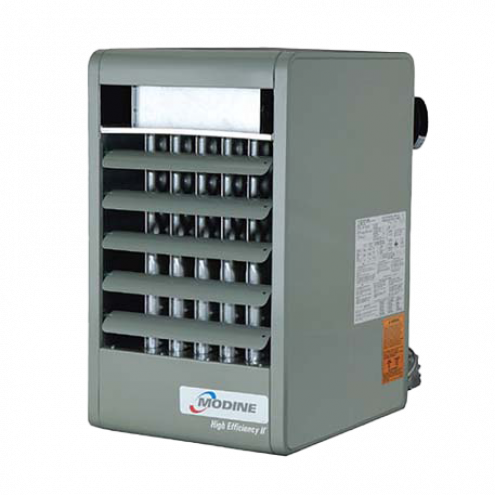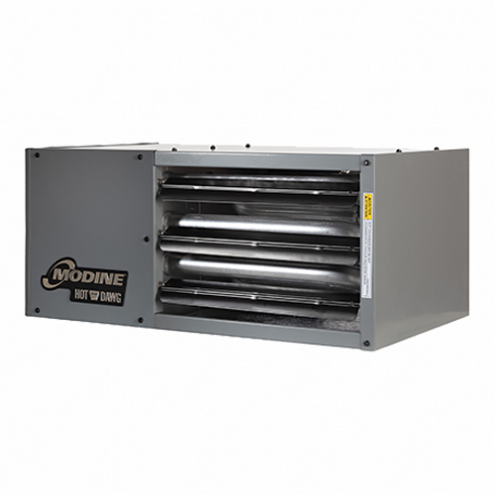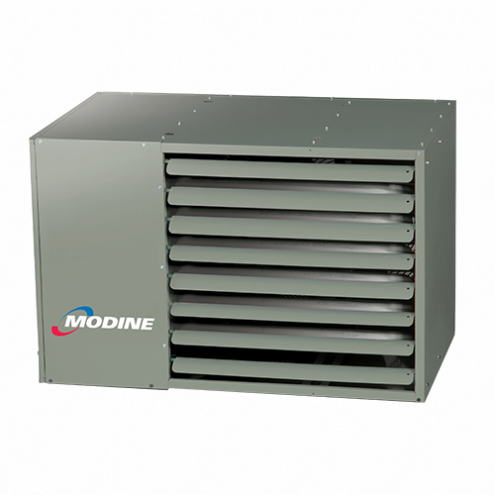CREATING THE PERFECT HEATING ENVIRONMENT
IN-FLOOR HEATING
Floor heating in greenhouses has become more and more popular over the past decades because of the considerable benefits warm floors can have on greenhouse crops. In-floor heat is desired because it counteracts the heat loss that occurs from a cold concrete surface in the greenhouse; it is also non-obtrusive as it is beneath the growing surface.
Flood Floors
With fluctuating energy prices and a growing concern for the environment, there has been an increasing demand for renewable and efficient heating systems in recent years. Modern wood heating technology, a key player in biomass greenhouse solutions, is ready for the challenge.
Sustainable
CO2-Neutral
Economical
High-Tech and Reliable
Local and Independent
Advantages of Flood Floor Heating
- Heating zones can be separated for individual climate control for different crops
- Best for providing uniform heating to the entire crop
- Heated concrete floor cuts down on condensate on poly roof, this allows more solar energy to pass through poly, conserving energy
General Advantages of Flood Floors
- Maximizes growing area by eliminating need for walkways, more plants per square foot
- Long life – lasts as long as the structure
- Labor savings possibilities, use of conveyors, spacing machines, fork lifts, bring carts right to growing area
- If not in use, empty areas can double as storage areas or customized work stations
In Ground Heat
If heating the growing media directly is desired, we have custom made flexible polyethylene piping that can be buried directly in the growing beds.
This piping is UV resistant, and resistant to chemicals and low temperatures. Instead of covering with concrete, a layer of small pea gravel is used to protect the pipe.
Just as in flood floors, warming the root zone results in even temperatures and even crop growth. The Niagrow design team uses 25mm diameter polyethylene pipe loops in the ground for all in-floor heating. The loops are connected to the steel distribution lines for hot water supply and cooler return water. The steel distribution lines are connected to main line piping that receives the hot water from a central boiler system.
These systems are designed with the crop needs in mind; because of the close proximity of the heating pipe to the roots of the crop, a lower heating temperature is used to provide the entire growing area with even temperatures.
Gallery
OVERHEAD HEATING
Overhead heating is important in areas that get seasons with cold night time temperatures. It provides the supplementary heating required to combat these cooler temperatures. While providing additional heat for these cooler months the overhead heating system can also be integrated for use with hanging basket systems and monorail and bi-rail cart setups.
An overhead system with snow melt protection is the perfect solution for northern climates that get accumulated snowfall. A snowmelt protection system can be included as part of the overhead heating system. A dedicated snowmelt system can also be designed. This is especially beneficial in greenhouses that have energy curtains. A dedicated snowmelt system sits above the energy curtain allowing the curtain to remain closed while the snowmelt system operates conserving the energy being saved below the curtain.
Perimeter HEATING
Perimeter Heating Systems should always be used in cold weather climates in order to protect plants growing near side and end walls. A well designed Perimeter Heating provides supplemental heat along the sidewalls contributing to a uniform thermal environment throughout the greenhouse. Niagrow designs the perimeter heat in consideration with your complete system needs. Perimeter heating can be integrated into existing zone controls or can be controlled as a stand-alone system if extra perimeter heat is desired at night when a heat retention curtain is in use. All our steel heating tube is electric resistant weld tested and certified to ensure maximum life and a leak free system. Hot Dipped Galvanized hangers are sized for the tubing needed and fasten easily to structure sidewall and end wall posts.
Specific products you may be interested in:
- Hot Water Steel Pipe
- Pipe Hangers
- Pipe Fittings
Under Bench HEATING
Under bench Heating Systems maintain uniform temperatures and positively affect the microclimate of plants. Air movement caused by the warmer under bench pipe reduces the humidity around the plant. Such systems are suitable for plants grown on benches, fixed tables, rolling, or transportable tables.
Learn More
An under bench heating system can reduce fuel costs 10 percent or more. Air temperature in the greenhouse can be 5 to 10 degrees lower than the growing medium temperature and still achieve excellent growth. This lower air temperature means that the heat loss between the inside of the greenhouse and outside will be less.
Uniform temperature in the root zone is difficult to achieve with unit heaters that circulate heat over the top of the crop or a boiler that pumps water through fin radiation along the sidewalls. Distributing the heat under the benches warms the growing medium first before it rises to heat the air. For most crops, the medium temperature is more critical to good growth than the air temperature.
Depending on the width of the benches or containers, Niagrow designs under bench systems accordingly using loops of steel pipe or forcas tubing if preferred. The heating pipe can either be supported on the ground by rose-pin style supports, or hanging from the bench itself.
Fire Box BOILERS
Niagrow is constantly in touch with the needs of the commercial greenhouse industry and can offer a high level of flexibility in design to match the best product to the application. The wetback “firebox” high mass boiler is ideal for greenhouse heat applications; they offer excellent combustion efficiency, compact size, simple design and reliable serviceability.
- Available with gas, oil, or multi-fuel burners.
- Each boiler is built to exacting quality standards and test-fired before shipping
- Most cost efficient boiler design with low cost replacement parts
- Compact design, will fit where other designs of similar capacities cannot
- Easy to clean and maintain, no special knowledge or skill required
Fire Tube BOILER
Niagrow can provide fire-tube boilers for various applications. A fire-tube boiler is a cylindrical high mass pressure vessel where hot flue gases pass through many small diameter tubes set within a tank of water. These hot gases transfer the heat through the walls of the tubes into the water.
- Easy to clean and maintain
- Tube replacement is straightforward
- Relatively compact
- One unit can provide a larger heat output. Up to 1500 BHP (47,588,000 Btu/hr)
- Vessel can hold a large amount of water, allowing boiler to respond to load changes with minimum pressure variation
High Efficiency Condensing Boiler
Greenhouse producers of all sizes will benefit from the high thermal efficiency of a condensing boiler while maximizing growing space. Condensing boilers increase heating efficiency by reducing energy costs and saving growing space in the process.
- 99% thermal efficiency compared to 80% of firebox boiler
- Fully modulating 5:1 turndown with the ability to fire as low as 20% up to 100% maximum output to perfectly meet the heating load
- Variable speed boiler pump for perfect control and efficiency
- Small lightweight design
- Easy to use with a colour touch display
- No need to protect against boiler shock, means a simplified hydronic loop (cost savings)
- Available up to 350 BHP (multiple units can be staged together to increase BHP output)
Learn More
Investing up front in a condensing boiler will result in more long-term savings. While condensing boilers typically cost up to 50% more than conventional options, the payback from 99% thermal efficiency and lower fuel use is expected to provide a rapid return on investment in less than five years.
Growers adopting high-efficiency options like condensing boilers may be eligible for grants or loans through the Rural Energy for America Program (REAP) and the Environmental Quality Incentives Program (EQIP).
Operating costs for medium and large size heating systems are often not given due consideration. By modernizing the heating boilers, energy consumption and environmental impact can be reduced considerably.
Carbon Dioxide (CO2) Dosing
Carbon dioxide (CO2) is an important element for plants. Carbon deficiency becomes a problem in tight and closed greenhouse environments during daytime hours when photosynthesis occurs.
The only solution is CO2 supplementation. Central dosage of CO2-rich flue gasses from gas burning boilers has led to a considerable production increase in greenhouse horticulture.
Learn More
- CO2 dosing improves plant growth and vigour
- Increases crop yield and can reduce heating costs
- Fluegas from natural gas-fired burners is very suitable for CO2 dosing
- Fluegas condensers increase the efficiency of your boiler dramatically
Fluegas condensers come in many sizes and kinds. With a condenser you raise the efficiency of your boiler dramatically. The engineering staff at Niagrow will include a fluegas condenser in your heating system design to maximise the efficiency of your boilers and to take advantage of the supply of CO2 that your boiler provides.
From the fluegas condenser the CO2 is distributed through the greenhouse with custom piping by a special exhaust fan designed specifically for this purpose.
We also supply an extensive range of material that form part of a complete CO2 system. Our engineering and design team has the ability to calculate the complete network of pipes required to optimally distribute carbon dioxide throughout the greenhouse.
Condensers
GGS can provide flue gas condensers that are unique in their kind. They are the only flue gas condensers that are completely made of stainless steel. These high-quality flue gas condensers are high efficiency compact segment condensers with a large heated surface. Many greenhouse horticultural companies use multiple boilers. One condenser can be supplied to service multiple boilers as a so-called combi-condenser. Using a condenser takes advantage of the latent heat stored in the exhaust gases (typically 450 – 650°F) created by the boiler that would normally be wasted up the chimney. The condenser diverts the boiler flue gases allowing it to heat the cool heating system water.
Expansion SYSTEMS
In a closed loop hydronic system, some suitable means must be supplied to accommodate the expansion of water volume and the added pressure within the heating system when heated to normal operating temperatures. Specially designed ASME Code tanks are necessary for this application and should be rated to withstand system pressure and temperature. A wide range of tanks are available. The importance of purchasing the correct size and design of expansion/compression tank is very important.
GGS supplies a closed tank system which utilizes air pressure to control water volume with a bladder, and an open tank system. The open tank system uses a metal tank without a bladder, excess water flows into the tank and is pumped out when the system needs it. Water glass fixtures or gauges are standard on Expansion/Compression tanks and tank mounted low water cut-offs are available.
Heat EXCHANGERS
Heat exchangers are used for many different purposes in a greenhouse. Any time you need to heat a water supply with your boiler system but need to keep the two separated a heat exchanger is the answer. Some examples are:
- Irrigation water pre-heat
- Heating of growing pools
- Potable hot water for bathrooms and lunchrooms
- Converting steam to a hot water heating system
We provide heat exchangers in three styles:
Brazed Plate Heat Exchangers:
These are low cost high efficient units suitable for all hot water boiler applications. Because of the design of this type of heat exchanger it offers higher heat transfer in a smaller package resulting in a more compact unit.
Plate and Frame Heat Exchangers:
These are similar in design to the brazed plate units except plates are mounted on a frame and bolted together. These units are expandable and can be changed to meet the needs of new load requirements by adding or subtracting plates.
Shell and Tube Heat Exchangers:
Typically we use these when we are required to use steam to supply heat to a hot water system. The heat exchanger consists of an outer shell that contains a series of smaller tubes inside. Steam is fed into the outer shell while cool water is fed into the smaller tubes causing the water to absorb heat.
Pipe INSULATION
Considerable fuel is wasted each year from bare heating system pipes in areas where heat is not needed. Often in boiler rooms the main pipe lines from the boilers are not insulated – this represents unnecessary heat loss and can cost the grower valuable energy. The amount of heat loss from a heating pipe depends on three things; the temperature of the pipe, the diameter of the pipe, and the conditions surrounding the pipe. Basically, the energy loss from the pipe is higher as the temperature within the pipe rises, as the diameter increases, and as the temperature around the pipe gets lower.
To avoid such energy losses the GGS design team considers this heat loss and insulates where necessary. The insulation used by GGS is 2” – 2.5” covered in an aluminum jacketing. This insulation properly insulates hydronic piping with the aluminum jacketing providing a professional, neat appearance in the greenhouse environment. The jacketing comes with a factory applied moisture barrier to keep the insulation dry and it actually reflects the light in the greenhouse rather than taking light away from the plants.
Heat STORAGE TANKS
A relatively new concept to the greenhouse industry is to use hot water storage with alternate fuel (biomass) heating systems to limited cycling. Systems, such as wood, burn most efficiently if operated at a constant fire rate. Adding a large, insulated hot water buffer tank can store excess heat during the daytime operation to be used at night when the heat demand is the greatest.
Learn More
Heat storage tanks are also fairly common in operations that use their boiler system to generate CO2 during the day. Like the biomass system this hot water is stored for use when CO2 production isn’t required.
Tanks with capacities of up to 1,000,000 litres are available. They are usually steel with an interior liner or anti-rust coating and heavy insulation on the outside. An exterior aluminum jacket protects the insulation. Most tanks are assembled on site.
Design of these systems allows for a smaller boiler as the water storage carries part of the nighttime load. Typical design looks at the maximum heat needs for the coldest day. It also considers the maximum tank water temperature that can be achieved, the lowest water temperature that can be used and the storage period.
Having a heat storage tank can also add piece of mind. In the case of a boiler failure a heat storage tank can supply 12-24 hours of hot water to sustain operation until repairs can be made.
Unit Heaters
GGS can also design systems to heat your warehouse or greenhouses with unit heaters. We typically use the following units depending on the application.
Power Vented Unit Heater
Power vented gas fired unit heaters provide 80% thermal efficiency and are available with stainless steel heat exchangers and stainless steel burners which are optimum for greenhouse conditions. These units can be vented vertically or horizontally.
High Efficient Condensing Unit Heater
A conventional unit-heater does not use all available combustion heat. A significant amount of heat is still present in the exhausted flue gases. Condensing unit heaters have a secondary heat exchanger installed extracting extra heat from that flue gas. This allows condensing units to reach 93% efficiency. These units are available with stainless steel heat exchangers and stainless steel burners which are optimum for greenhouse conditions. These units can be vented vertically or horizontally.
Hydronic Unit Heater
Hydronic unit heaters are compact and lightweight making them ideal for greenhouse use. These units are able to use the hot water or steam supplied by the greenhouse boiler system to generate heat. The ability to attach the supply piping to the top and bottom or the side of the unit allows for installations in all situations, especially low clearance installations found in older structures.
Why Choose GGS?
GGS guarantees customer satisfaction. Featuring a team made up of professionals in the industry, this greenhouse designing, manufacturing, and installing company provides high-quality, long-lasting structures both on-time and on-budget. GGS works with growers of a variety of crops and is committed to delivering structures that help protect and improve the quality of the plant environment.


